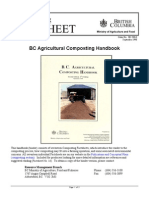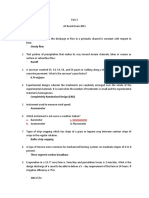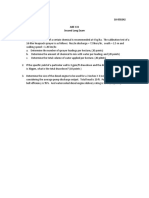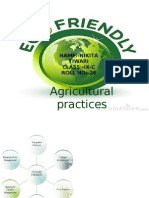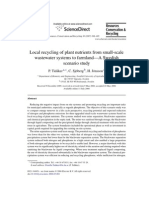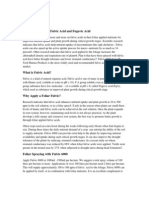9 Cauliflower PDF
9 Cauliflower PDF
Uploaded by
IJEAB JournalCopyright:
Available Formats
9 Cauliflower PDF
9 Cauliflower PDF
Uploaded by
IJEAB JournalOriginal Title
Copyright
Available Formats
Share this document
Did you find this document useful?
Is this content inappropriate?
Copyright:
Available Formats
9 Cauliflower PDF
9 Cauliflower PDF
Uploaded by
IJEAB JournalCopyright:
Available Formats
International Journal of Environment, Agriculture and Biotechnology (IJEAB) Vol-4, Issue-4, Jul-Aug- 2019
http://dx.doi.org/10.22161/ijeab.449 ISSN: 2456-1878
Cauliflower (Brassica oleraceavar. botrytis L.)
Production Applied with Carabao Manure:
Effects on Growth and Yield
Leah C. Tuan, Ph.D
*Associate Professor, Department of Agricultural Sciences, College of Agriculture, Fisheries, and Natural Resources,
University of Eastern Philippines, University Town, Northern Samar, Philippines
Email: leahtuanc@gmail.com
Abstract— Utilization of carabao manure as a sustainable approach on nutrient management for cauliflowe r
production was studied for three months between the months of October 2016 to January 2017 at the University
Demo Farm, University of Eastern Philippines, Main Campus, University Town, Catarman, Northern Samar ,
Philippines. The main objective was to determine the effect of carabao manure on the growth and yield of
cauliflower. Carabao manure preparations included dried carabao manure, administered at 1.0 kg and 1.5 kg
levels boosted with manure tea.
Growth and yield performance of cauliflowers were significantly influenced by dried carabao manure
applications boosted with manure tea application. Better performance were observed in plants treated with 1.5
kg dried carabao manure than with 1.0 kg was evident on the paramet ers evaluated, indicative of the nutrient
sufficiency of the bio fertilizer.
Carabao manure, a farm waste product, an untapped resource, has been proven to be an effective, safe and an
economical bio organic fertilizer. A commodity capable of becomin g a promising industry; a lowly resource,
but if given enough attention can “turn dust into gold” and effect significant changes in the lives of many sort.
Keywords— Animal wastes, Bio-organic fertilizer, Carabao manure tea, Dried carabao manure.
I. INTRODUCTION growth because of the decomposing microorganisms in
Nutrient management and insect pest control are the rumen and hormones in their urine.
indispensable in any farming endeavour. Undoubtedly, With these, the study was conceived to test the
the use of most appropriate technology suited to a given efficacy of carabao manure as fertilizer as bio fertilizer on
croplargely contribute to its growth and yield. the growth and yield of cauliflower grown pots.
The utilization of indigenous farm resources
such as farm manure and botanicals relative to crop II. METHODOLOGY
management as an organic production technology has a Experimental Design and Treatments. A
good number of assured chain of benefits which are: randomized complete block design (RCBD) with three
environmental sanitation or ecological conservation, replications was used. Three doses of bio-organic
reduction of production cost resulting to bigger income, fertilizer from animal wastes were evaluated, to wit: No
and production of genuinely safe food crops to address carabao manure (DCMO -control); 1.0 kg dried carabao
and promote health and wellness concerns. manure (DCM1) and 1.5 kg dried carabao manure
Carabaomanure, is a very good bio material for (DCM1.5). The treatments were designated as follows:
enhancing soil fertility. This bio-organic resource can be T1: DCMO - No Carabao Manure
collected in every farm. Rosco, 2014, (personal (DCMO-Control)
communication), mentioned that a carabao produces ten T2: DCM1 - 1.0 kg Carabao
(10) kilos of manure a day. Chemical analysis shows that Manure
carabao manure has 18-20 C:N ratio. It has 24-30% T3: DCM1.5 - 1.5 kg Carabao manure
carbon, 0.8-2.2 % Nitrogen, 2.07 Phosphorus, and 0.12- Preparation and Application of Carabao
2.0 Potassium (Aganon, et al., 2011). They further cited Manure as Bio-organic Fertilizer. Carabao manure was
that manure from ruminants is found to enhance plant processed in two ways: dried (DCM) and manure tea
(CMT). Dried carabao manure was collected and air-
www.ijeab.com Page | 948
International Journal of Environment, Agriculture and Biotechnology (IJEAB) Vol-4, Issue-4, Jul-Aug- 2019
http://dx.doi.org/10.22161/ijeab.449 ISSN: 2456-1878
dried until it was totally dried, while carabao manure tea tea; and El-Magd, et al., (2016), noted accelerated growth
was processed by submerging a sack-full of partially of the plants applied with organic manure.
dried carabao manure in a 200-liter capacity plastic drum Number of Leaves per Plant at
filled with ground water for one week before its use. Harvest.Although the number of leaves produced per
Dried carabao manure (DCM) was prepared in plant varied according to carabao manure application, the
two levels: 33 and 50 t/ha converted into 1.0 kg (DCM1) same was not significant. The production of almost the
and 1.5 kg (DCM1.5), respectively. Application of DCM same number of leaves with or without the application of
was done once for DCM1 and twice for DCM1.5. different levels of DCM indicates that the cauliflower
Application of DCM1 was adminstered as basal before variety used in the study can adapt to local conditions
planting; while second application for DCM1.5 as top even in soils with low fertility level. This observation is
dress was done 10 days after the first application. Carabao true in almost all vegetable (Brassica) researches in the
manure tea (CMT) at the rate of 100 ml plant was applied area where the control (without fertilizer application)
in each plant at planting and at weekly interval thereafter plants were able to develop considerable number of leaves
throughout the duration of the study. Application was but of different length, breadth and weight subject to
directed in the soil at the base of each plant. available nutrients in the soil (Tuan, 2002).
Planting and Harvesting. Hardened cauliflower Leaf Length at Harvest (cm).Length of
seedlings (Farmers’ Extra Early variety) were cauliflower leaves was significantly affected by the
transplanted to the plastic pots filled with desired volume application of carabao manure. Longest leaves were
of soil medium and bio-organic fertilizer late in the found in DCM1 (19.55 cm) and DCM1.5 (21.02 cm);
afternoon to reduce transplanting shock. The plants were shortest leaves were noted in DCM0 (15.32 cm). Higher
maintained using recommended cultural management rates of carabao manure produced bigger and longer
practices. Gowth and yield was measured in terms of leaves. This implies that DCM added with CMT
plant height, length and width of leaves, leaf area and provided adequate nutrients to the cauliflowers. This
weight at harvest, weight of whole plant, root-shoot-ratio, corroborates the findings of Fayed (2010) who claimed
number of days to 50% flowering, weight and diameter that CMT significantly increased the vegetative
of curd and yield of marketable curds. Harvesting was parameters of the Roghini olive trees. In addition, El-
done when the curd became compact and firm or about tantawy (2009) also found out that farmyard compost tea
50 days from transplanting. Data gathered were analyzed increased the height and leaf area of potato plant.
employing the analysis of variance (ANOVA) and LeafWidth at Harvest (cm).Plants applied with
treatment mean differences were determiend using the DCM1 and DCM1.5 produced the widest leaves while
Least Significance Difference (LSD) test at 5% level of those applied with DCMO only had the narrowest
probability. leaves.The production of wider leaves in cauliflowers is
necessary to support flower/curd formation. Results of
III. RESULTS AND DISCUSSION this study revealed that formation of bigger and wider
Growth Characters leaves is directly related to the application of DCM with
Growth characters as influenced by the CMT as sources of nutrient. Gross et al.(2008), reported
application of carabao manure as bio-organic fertilizer are that ammonium is the major form of nitrogen present in
summarized in Table 1. the extract solutions from all manure types and that the
Plant Height at Harvest (cm).Plants applied nitrogen released after 14-day extraction by the different
with 1.0 kg dried carabao manure (DCM1) were tallest, methods from the different manures ranged between 50%
39.83 cm followed by plants applied with1.5 kg dried and 85%. Alo and Tuan (2015) obtained almost similar
carabao manure or (DCM1.5) with 38.35 cm. Plants were result in cauliflower applied with chicken dung.
shortest in pots without dried carabao manure (DCM0) at Leaf Area at Harvest (cm).The application of
35.05 cm.Although carabao manure is considered a slow DCM significantly influenced the leaf area of cauliflower
release organic fertilizer, its effect might have been plants. Highest leaf area was recorded among plants
enhanced by the application of carabao manure tea applied with DCM1 with 654.26 cm2 and those with
(CMT), boosting plant nutrients at early crop stage DCM1.5 with 632.84 cm2 . Lowest leaf area was observed
resulting to the rapid growth of the cauliflowers.Jigmei, in the control plants (DCM0) with 403.71cm2 . No
N.J., et al., (2015) reported an increase in growth significant difference in leaf area was observed between
parameters of broccoli applied with chicken and manure DCM1 and DCM1.5. The variation in leaf area observed
among treatments being bigger in plants applied with
www.ijeab.com Page | 949
International Journal of Environment, Agriculture and Biotechnology (IJEAB) Vol-4, Issue-4, Jul-Aug- 2019
http://dx.doi.org/10.22161/ijeab.449 ISSN: 2456-1878
DCM than those in control plants (DCM), implies that observed that maximum root growth and rooting depth of
DCM has sufficient nutrients. Nourishment received by barley crop were higher in treatments, which received
the plants enabled the production of bigger and wider animal manures relative to where manure was not applied.
leaves; a plant requirement that allow optimum light The results therefore suggest that the observed response
interception and distribution for efficient physiologic was largely due to increased availability of N and P in
process such as photosynthesis and carbohydrate transport Carabao manure and manure tea and consequently
(El-Sawy et al., 200; el-Dissoky, 2008) which contribute enhanced root growth.
to the formation of reproductive parts in cauliflower. Yield Parameters
Leaf Weight at Harvest (g).Different rates of Yield parameters as influenced by the
DCM had significant influence on the weight of application of carabao manure as bio-organic fertilizer are
cauliflower leaves per plant. Average leaf weight per presented in Table 2.
plant was heaviest in DCM1 at 381.39 g, and DCM1.5 Number of Days from Transplanting to 50%
with 375.55 g, but no significant difference was observed Flowering.The number of days from transplanting to 50%
between them.Lightest leaves were observed in plants not flower/curd formation as influenced by the application of
applied with DCMO (213.09 g). The variation in leaf the different rates of DCM wassignificant. Flowering/curd
weight among treatments is directly related to the size of formation was earliest, 42.29 days in plants applied with
the leaves (leaf length, width, area) produced by the DCM1.5 but delayed for about three days, 45.25 in plants
plants. Based on the other growth parameters, it can be applied with DCM1, and up to five days, 48.54
noted that the longest and widest leaves and biggest leaf inuntreated plants. Notably, the cauliflower variety
area were produced by the plants treated with DCM. (Farmers’ Extra Early) used in this study is an early
Gross et al., 2008, mentioned that organic fertilizers have maturing variety, produces curds which can be harvested
the property to enhance soil aggregation, soilaeration, and within 40 days from transplanting. Based on the results,
water holding capacity; factors which offer good generally, plants which were organically fertilized
environmental condition to broccoli plants. flowered earlier compared to those which were not
Weight of Whole Plant at harvest.Weightof fertilized; possibly due to better nourishment. The lack of
whole plants differed significantly as influenced by the nutrients for immediate utilization in control plants may
application of DCM. Average weight of whole plants have contributed to the delay in flower/curd formation.
applied with DCM1 was 235.83 g and DCM1.5 with Curd Diameter (cm) at Harvest. Curd diameter
221.20 g were statistically the same except on plants considerably differed among the treatments evaluated.
without DCM with 139.12 g. Weight of whole plant Cauliflowers applied with DCM1.5 produced the biggest
comprises all plant parts including the roots. The results curd, 11.68 cm, those applied with DCM1 produced
of the study relative to the weight of the whole plant smaller curd, 10.06 cm. Plants which did not receive
almost follow similar pattern with the other growth DCM produced undersized curds (7.64 cm. The
parameters evaluated such as the vegetative parts (leaf production of bigger curd in the fertilized treatmentscan
length, width and leaf area). The increase in vegetative be attributed to the cumulative contributions of healthy
growth can be traced back to the positive effects of DCM vegetative plants parts produced in plants receiving
with CMT which have contributed to the increase in organic fertilizer as results of readily available nutrients
photosynthetic activity and uptake of soil nutrient. These and better mobilization of plant nutrients translocated by
results are in agreement with the findings of Caser (2009) the application of bio-fertilizer.
in cauliflower, Elkhatib, (2009) on common bean. Curd Weight at harvest. Results of the study
Shoot-Root Ratio.Shoot-rootratio was highest in relative to the application of different rates of DCM
plants treated with DCM1.5, 8.33 g followed by plants revealed positive impact on weight of cauliflower curd.
treated with DCM1.0 with 8.85 g and those without DCM Consistently, those applied with dried carabao manure
at 6.77 g per plant. Although highest shoot- ratio was (DCM1 and DCM1.5) showed the heaviest curds, while
highest in plants applied with DCM1.5 followed by plants those without carabao manure (DCMO) had the lightest.
applied with DCM1 and those without carabao manure In harmony with other growth and yield parameters
(DCMO), in the descending order, the differences were evaluated in this study, treatments administered with
not significant. The higher shoot-root ratio among DCM and CMTalso registered heavier curds. Better
treatment treated with organic fertilizer is indicative that growth and yield performance are manifestations of
the plants were receiving sufficient nutrients to support a nutrient sufficiency provided to the plants by the bio
large vegetative (shoot) growth. Wright et al. (1995), organic resources.
www.ijeab.com Page | 950
International Journal of Environment, Agriculture and Biotechnology (IJEAB) Vol-4, Issue-4, Jul-Aug- 2019
http://dx.doi.org/10.22161/ijeab.449 ISSN: 2456-1878
Table 1. Growth characters of cauliflower as influenced by the application of carabao manure.
Mean*
Treatments Plant Number Leaf Leaf Leaf area Leaf Weight Root-
Height of leaves length at width at at harvest weight at of whole shoot
(cm) per plant harvest harvest (cm2 ) harvest Plant (g) Ratio
(cm) (cm) (g)
M0 35.05b 16.18 15.32b 9.18b 134.57b 71.03b 19.87b 6.77
M1 39.83a 17.06 19.55b 11.38a 218.09a 125.18a 27.24a 7.42
M2 38.35a 17.06 21.02a 11.83a 210.95a 127.13a 25.58a 8.33
*Means followed by the same letter are not significant at 5% DMRT.
Average Yield of Marketable Curd Yield conducive and nutritionally sufficient). Expectedly, plants
(t/ha).Yield of marketable curd greatly varied as affected by reared in such condition had produced big and heavy curds.
the application of dried carabao manure but failed to Based on the production indices evaluated in this study, the
register significant differences between treatments . Higher application of carabao manure as an organic bio fertilizer
yield in plants applied with carabao manure and carabao supplemented with manure tea almost resulted to sizable
manure tea is the concrete manifestation of the overall plant vegetative growth.
performance given favourable environment (physically
Table 2. Yield characters of cauliflower as influenced by the application of carabao manure.
Mean*
Treatments Number of Days to Curd diameter Weight of marketable Yield of marketable
50% Flowering at harvest curd at harvest curd
(cm) (g) (t/ha)
M0 48.54a 7.64c 74.56b 2.44
M1 45.25b 10.06b 184.26a 3.05
M2 42.29c 11.68a 208.29a 3.59
*Means followed by the same letter are not significant at 5% DMRT.
IV. CONCLUSION AND RECOMMENDATIONS productive and sustainable organic cauliflower production.
The application of carabao manure complemented A follow-up study is necessary to further verify the
with carabao manure tea as source of bio-organic fertilizer performance of cauliflower applied with carabao manure
for cauliflower production was found to have highly with manure tea under farmers field conditions.
influenced the growth and yield of cauliflowers, evident on
the different growth and yield parameters evaluated, such as ACKNOWLEDGEMENT
plant height, length and width of leaves, leaf area and The researcher wish to express her profound
weight at harvest, weight of whole plant, root-shoot-ratio, thanks to the University of Eastern Philippines (UEP)
number of days to 50% flowering, weight and diameter of administration and the Commission on Higher Education
curd and yield of marketable curds. Carabao manure with (CHED) for the material and financial support that leads in
manure tea was found to be effective in influencing growth the realization of this experiment. To the University
and yield of cauliflower. Higher rates of carabao manure Research and Development Services staff, and field workers
enhanced with manure tea resulted to bigger and heavier who assisted the researchers throughout the duration of the
plants and eventually higher yield of marketable experimentation.
cauliflowers.
Carabao manure and carabao manure tea, a farm REFERENCES
waste, is rich in plant nutrients and beneficial [1] Abou El- M agd, M .M ., A.M , El-Bassiony and Z.F. Fawzy .
microorganisms is a potential bio-organic fertilizer 2016. Effectof Organic M anure with or Without Chemical
www.ijeab.com Page | 951
International Journal of Environment, Agriculture and Biotechnology (IJEAB) Vol-4, Issue-4, Jul-Aug- 2019
http://dx.doi.org/10.22161/ijeab.449 ISSN: 2456-1878
Fertilizerson Growth,Yield and Quality of Some Varieties of [15] Samonte P. M arch 2013. “Organic Farming Develops Roots
Broccoli Plants In Pampanga”. Agriculture M onthly. Vol 17, Issue No. 3 pp
[2] Alo, L.D. and Tuan, P.P. 2014. Growth and Yield of 52-53.
Cauliflower(Brassica oleracea) Applied with Chicken Dung-
based Organic Fertilizer under Polyethylene Pot Culture.
UEPGS M S Thesis.
[3] Caser G. Abdel.2009. Improving the Production of Well
Irrigated Cauliflower (Brassica oleraceavar.Botrytis,Cv.
Snowball Y. Imp) by Foliar Spraying of some Growth
Regulators. Journal of ZankoySulaimani12(1), 29-49.
[4] DOST. (1998): M adre de cacao. Department of Science and
Trade. M anila, Philippines.Stoll, G. (2000): Natural
protection in the tropics. M argrafVer
Weikersheim.www.bar.gov.ph
[5] El-Dissoky, R. A. 2008.Studies on the use efficiency of
potassium and organic fertilizers on potatoes and its role in
improving soil properties.PhD Thesis. Faculty of
Agriculture, M ansoura, University,Egypt.
[6] Elkhatib HA. 2009. Growth and yield of
commonbean(Phaseolus vulgaris L.) in response to
Rhizobium Inoculation, nitrogen and molybdenium
fertilization. Alex. Sci.Exchange Journal 30, 319- 332.
[7] El-Sawy, B. I., Radawan, E. A. and Hassan, N. A. 2000.
Growth and yield of potato as affected by soil and foliar
potassium application. Journal of Agriculture Science,
25(9):5843-5850.
[8] El-Tantawy, I. M ., El-Ghamry, A. M . and Habib, A. H.
2009. Impact of farmyard manure and manure compost tea
on potato yield and soil fertility. Journal of Agriculture
Science, 34(1): 669 – 678.
[9] Fayed, T. A. 2010. Optimizing yield, fruit quality and
nutrient status of Roghiani olive grown in Libya using some
organic extracts. Journal of Horticulture Science and
Ornamental Plants, 2(2): 63-78.
[10] Gross, A., Arusi, R. and Nejidat, A. 2007. Assessment of
extraction methods with fowl manure for the production of
liquid organic fertilizers. Bioresource Technology, 99: 327–
334.
[11] Jigme1, Nipon Jayamangkala1, PathipanSutigoolabud,
JiraponInthasan and Siriwat Sakhonwasee1.2015. The effect
of Organic fertilizers on growth and yield of Broccoli
(Brassica oleraceaL. var. italicaPlenck cv. Top Green)
Journal of Organic Systems, 10(1),
[12] PCARRD. 1999. Broccoli and Cauliflower Production
Guide. Information Bulletin No. 148. Los Banos 4030
Laguna.
[13] Rodriguez AA. January 2012. “Sariaya, Quezon Organic
Farmer Succeeds with Cauliflower”. Agriculture M onthly.
Volume 16, Issue 01. p. 44.
[14] Samonte P. August 2012 . “Bataan Farmer earns M illions
FromCalamansi and Vegetables”. Agriculture M onthly.
Volume 16, Issue 8. pp.20-21
www.ijeab.com Page | 952
You might also like
- Josiah Genao 1.01 Exploring Life Lab ReportDocument4 pagesJosiah Genao 1.01 Exploring Life Lab ReportJosiah PaulinoNo ratings yet
- Succession POGIL Answer KeyDocument1 pageSuccession POGIL Answer KeyNo NameNo ratings yet
- Diagnostic Test TLE 10Document2 pagesDiagnostic Test TLE 10danzel sugse73% (11)
- Exam Series 2001 2223Document5 pagesExam Series 2001 2223Yumi Jackylyn CrimonaNo ratings yet
- ABE 27 Physical Factors Which Make Up The EnvironmentDocument23 pagesABE 27 Physical Factors Which Make Up The EnvironmentRJ Lloren100% (1)
- AB Power Eng'g LabDocument2 pagesAB Power Eng'g LabJohn Henry Lucayon TenorioNo ratings yet
- BPP CO Product Costing v.0Document35 pagesBPP CO Product Costing v.0fharooksNo ratings yet
- Engr. Alexis T. Belonio, MS Agricultural and Biosystems Engineer ASEAN EngineerDocument12 pagesEngr. Alexis T. Belonio, MS Agricultural and Biosystems Engineer ASEAN EngineerMAPANAO RONALYN B.No ratings yet
- Irrig 2 PDFDocument3 pagesIrrig 2 PDFMichael Angelo AlbaoNo ratings yet
- Pre Board Area2Document13 pagesPre Board Area2Jane Denise RazoNo ratings yet
- Waste Management Structures: Philippine Agricultural Engineering Standards Agricultural Liquid WasteDocument72 pagesWaste Management Structures: Philippine Agricultural Engineering Standards Agricultural Liquid WasteEspeeNo ratings yet
- Microclimatic Modification PartsDocument12 pagesMicroclimatic Modification PartsJermaine Aceremo De CastroNo ratings yet
- II-6 Agronomy 1-23Document24 pagesII-6 Agronomy 1-23SannyBombeoJomocNo ratings yet
- Recalled QuestionsDocument5 pagesRecalled QuestionsEspeeNo ratings yet
- Rheological Properties of Food and Agricultural ProductsDocument7 pagesRheological Properties of Food and Agricultural ProductsRizki AhmadNo ratings yet
- SET A. Post Test Part 1Document8 pagesSET A. Post Test Part 1Cath EspanolaNo ratings yet
- Agricultural Composting HandbookDocument2 pagesAgricultural Composting HandbookGreater Charlotte Harbor Sierra ClubNo ratings yet
- 14 Bench TerracesDocument3 pages14 Bench TerracesRubybharat100% (2)
- Food and Beverage Manufacture Skill TestDocument40 pagesFood and Beverage Manufacture Skill TestHari PunNo ratings yet
- Hydromet & SWCE Glossary NEWDocument9 pagesHydromet & SWCE Glossary NEWKristine JavierNo ratings yet
- Abe 414Document4 pagesAbe 414JohnNo ratings yet
- Steady Flow: A. C. Seismometer BDocument4 pagesSteady Flow: A. C. Seismometer BJC Yabis100% (1)
- I. Soil-Water-Plant RelationshipDocument50 pagesI. Soil-Water-Plant RelationshipJose Carlo Dizon0% (1)
- UPLB - Farm Irrigation and DrainageDocument18 pagesUPLB - Farm Irrigation and DrainageVanessa Mae LacamentoNo ratings yet
- Growth Response of Eggplant (Solanum To Organic and Inorganic FertilizerDocument12 pagesGrowth Response of Eggplant (Solanum To Organic and Inorganic FertilizerJustine ReveloNo ratings yet
- Agricultural Machinery and Allied Subjects Withanswer KeyDocument9 pagesAgricultural Machinery and Allied Subjects Withanswer KeyPeter ian AutenticoNo ratings yet
- 2022-Part-Ii-Post-Test (Set A)Document6 pages2022-Part-Ii-Post-Test (Set A)Abas S. AcmadNo ratings yet
- III 5 CropProcessing 1 8Document8 pagesIII 5 CropProcessing 1 8SannyBombeoJomocNo ratings yet
- Unit II 2nd PartDocument3 pagesUnit II 2nd PartSachin BhardwajNo ratings yet
- Ab Ic - Review 1 - Part 1 and 2Document17 pagesAb Ic - Review 1 - Part 1 and 2NEIZELNo ratings yet
- Abe 424 Farm Structures and Environmental ControlDocument42 pagesAbe 424 Farm Structures and Environmental ControlAmabi SilasNo ratings yet
- Agricultural TractorDocument7 pagesAgricultural TractorEspeeNo ratings yet
- RA 10601 For PrintDocument12 pagesRA 10601 For PrintChristian Dave RoneNo ratings yet
- Ae Board Review Part3 Msword2003 Long Paper 2011Document13 pagesAe Board Review Part3 Msword2003 Long Paper 2011Debbie AristotelesNo ratings yet
- Soil & Conservation Report 1Document5 pagesSoil & Conservation Report 1Thabo ChuchuNo ratings yet
- AE-questions - Paper 1 PDFDocument26 pagesAE-questions - Paper 1 PDFnitin khariNo ratings yet
- Volume 2 Part 3Document110 pagesVolume 2 Part 3John CennaNo ratings yet
- Area 1Document7 pagesArea 1Krisher DhayNo ratings yet
- SWCEDocument115 pagesSWCEKen Lloyd F. PabilanNo ratings yet
- EXM - Area 2 - 2Document34 pagesEXM - Area 2 - 2Jane Denise RazoNo ratings yet
- Tillage and Tillage EquipmentDocument82 pagesTillage and Tillage EquipmentArnel SisonNo ratings yet
- Maize Residue As Substrate For Oyster Mushroom (Pleurotus Ostreatus) CultivationDocument10 pagesMaize Residue As Substrate For Oyster Mushroom (Pleurotus Ostreatus) CultivationpaulNo ratings yet
- Part 1 Mock Questions-YeahDocument4 pagesPart 1 Mock Questions-YeahMisheru Misaki AyuzawaNo ratings yet
- Term Paper On Aquaculture - Crab PondsDocument7 pagesTerm Paper On Aquaculture - Crab PondsWilson EjercitoNo ratings yet
- Pre-Board Questions 2005Document14 pagesPre-Board Questions 2005Rolly SawadNo ratings yet
- In-Situ Moisture Conservation Principle and PracticesDocument15 pagesIn-Situ Moisture Conservation Principle and Practicesmanikandan.v100% (3)
- Area 2 ProbsolDocument10 pagesArea 2 ProbsolKrisher DhayNo ratings yet
- Soil Water Part1Document22 pagesSoil Water Part1mnadelgadoNo ratings yet
- Rasper PDFDocument6 pagesRasper PDFShah WaliullahNo ratings yet
- Eloisa Mae S. Semilla - ABE 131 2nd LEDocument2 pagesEloisa Mae S. Semilla - ABE 131 2nd LEEloisa Mae Sotelo SemillaNo ratings yet
- Soil and Water COnservation Engineering (14-22) PDFDocument9 pagesSoil and Water COnservation Engineering (14-22) PDFRenel AluciljaNo ratings yet
- Ponds and AerationDocument25 pagesPonds and AerationRio Banan100% (1)
- Chapter 4 (Ag. Waste Characteristics) PDFDocument40 pagesChapter 4 (Ag. Waste Characteristics) PDFshii anihsNo ratings yet
- Subject: Agricultural Engineering LAW: Engr. Roland J. Macana Xavier University - Agricultural Engineering DepartmentDocument63 pagesSubject: Agricultural Engineering LAW: Engr. Roland J. Macana Xavier University - Agricultural Engineering DepartmentJC YabisNo ratings yet
- Farm Power and MachinaryDocument101 pagesFarm Power and MachinarySushant YadavNo ratings yet
- III 6 RicePostProd 1 8Document9 pagesIII 6 RicePostProd 1 8SannyBombeoJomocNo ratings yet
- AE - Problems and Solutions1Document16 pagesAE - Problems and Solutions1Regan Roldan RolaNo ratings yet
- Unit 1. Intro To Irrigation and DrainageDocument11 pagesUnit 1. Intro To Irrigation and DrainageMariam A. BumarasNo ratings yet
- ABE2 Exercise 2 Lab ReportDocument5 pagesABE2 Exercise 2 Lab ReportRica APEXNo ratings yet
- 2019 Edition-V6 AgElectrification-B&WDocument46 pages2019 Edition-V6 AgElectrification-B&WdarrelNo ratings yet
- JPP - Volume 11 - Issue 11 - Pages 1055-1062Document8 pagesJPP - Volume 11 - Issue 11 - Pages 1055-1062iffa afiqa khairaniNo ratings yet
- Optimization The Effect of Decanter Cake With Fermented Fertilizer of Cow Urine in Edamame Growth and YieldDocument7 pagesOptimization The Effect of Decanter Cake With Fermented Fertilizer of Cow Urine in Edamame Growth and Yieldvasantha vasuNo ratings yet
- Influence of Organic and Inorganic Fertilizers On Growth, Yield and Physio-Chemical Properties of PapayaDocument16 pagesInfluence of Organic and Inorganic Fertilizers On Growth, Yield and Physio-Chemical Properties of Papayamwah mwahNo ratings yet
- Greenhouse Gas Emissions From Aquaculture: A Life Cycle Assessment of Three Asian SystemsFrom EverandGreenhouse Gas Emissions From Aquaculture: A Life Cycle Assessment of Three Asian SystemsNo ratings yet
- Gender Involvement in Crop Production and Livestock Related Activities in Chitwan and Lamjung District of NepalDocument4 pagesGender Involvement in Crop Production and Livestock Related Activities in Chitwan and Lamjung District of NepalIJEAB JournalNo ratings yet
- A Review On Feed Additives Used in Fish DietDocument7 pagesA Review On Feed Additives Used in Fish DietIJEAB JournalNo ratings yet
- Development and Quality Evaluation of Ragi Supplemented CupcakesDocument4 pagesDevelopment and Quality Evaluation of Ragi Supplemented CupcakesIJEAB JournalNo ratings yet
- Optimized Recombinant Bacillus Subtilis 168 Whole-Cell Catalyzes One-Step Biosynthesis of High Fructose SyrupDocument9 pagesOptimized Recombinant Bacillus Subtilis 168 Whole-Cell Catalyzes One-Step Biosynthesis of High Fructose SyrupIJEAB JournalNo ratings yet
- Epidemiology and Determinants of Soil-Transmitted Helminthiases Among Selected Primary School Children in Tuguegarao City, Cagayan, Philippines: A Cross-Sectional StudyDocument4 pagesEpidemiology and Determinants of Soil-Transmitted Helminthiases Among Selected Primary School Children in Tuguegarao City, Cagayan, Philippines: A Cross-Sectional StudyIJEAB JournalNo ratings yet
- Prediction of High-Risk Probability Areas Under Current and Future Climate Scenarios in India For The Establishment of Fall ArmywormDocument30 pagesPrediction of High-Risk Probability Areas Under Current and Future Climate Scenarios in India For The Establishment of Fall ArmywormIJEAB JournalNo ratings yet
- Effect of Polysaccharides (Pectins) On Postprandial GlucoseDocument7 pagesEffect of Polysaccharides (Pectins) On Postprandial GlucoseIJEAB JournalNo ratings yet
- Elemental Composition and Proximate Analysis of Shea Butter Sold in Swali Market, Yenegoa, NigeriaDocument5 pagesElemental Composition and Proximate Analysis of Shea Butter Sold in Swali Market, Yenegoa, NigeriaIJEAB JournalNo ratings yet
- Investigation of Cowpea Variety and Storage Methods On Cowpea Beettle InfestationDocument6 pagesInvestigation of Cowpea Variety and Storage Methods On Cowpea Beettle InfestationIJEAB JournalNo ratings yet
- Investigating Pesticide Use and Management in King Orange (Citrus Nobilis) Farming in Vung Liem District, Vinh Long Province, VietnamDocument6 pagesInvestigating Pesticide Use and Management in King Orange (Citrus Nobilis) Farming in Vung Liem District, Vinh Long Province, VietnamIJEAB JournalNo ratings yet
- Oxigen FertilizersDocument7 pagesOxigen FertilizersatulkalaskarNo ratings yet
- Importance of Agriculture in Modern IndiaDocument3 pagesImportance of Agriculture in Modern IndiaVajith RaghmanNo ratings yet
- Aag 301 - 2017-2018-Rku PDFDocument3 pagesAag 301 - 2017-2018-Rku PDFGanpat Lal SharmaNo ratings yet
- Cassia Sp.Document20 pagesCassia Sp.John PeterNo ratings yet
- Agric JSS 1Document4 pagesAgric JSS 1elvis greyNo ratings yet
- Urban Gardening Fact Sheet PDFDocument12 pagesUrban Gardening Fact Sheet PDFWaqas MurtazaNo ratings yet
- List of Fertilizers For FertigationDocument2 pagesList of Fertilizers For FertigationAnonymous m7pS4cmaDNo ratings yet
- Japs-4 1 1Document7 pagesJaps-4 1 1CourageNo ratings yet
- Ent-354 - Notes Cum Manual YTJ - FDocument66 pagesEnt-354 - Notes Cum Manual YTJ - FNiraj GurjarNo ratings yet
- Organic Vegetable Production DepEdDocument93 pagesOrganic Vegetable Production DepEdAlmaira SumpinganNo ratings yet
- Unit 5 Exam NomenclatureDocument3 pagesUnit 5 Exam Nomenclatureapi-273525891No ratings yet
- Ae 354 20072022Document51 pagesAe 354 20072022Amoako DerrickNo ratings yet
- Fever Tree: Agriculture, Forestry & FisheriesDocument16 pagesFever Tree: Agriculture, Forestry & FisheriesDylanNo ratings yet
- Eco Friendly Agricultural PracticesDocument9 pagesEco Friendly Agricultural Practicesradhe47No ratings yet
- TLE 9 Group 1 (Shane)Document14 pagesTLE 9 Group 1 (Shane)gregorioleighsybellNo ratings yet
- Vol. 2-BoQ, Tech. Spec. & Drawings-Landscape and Irrigation-NCSCMDocument49 pagesVol. 2-BoQ, Tech. Spec. & Drawings-Landscape and Irrigation-NCSCMAbdul Rahuman100% (1)
- Fertilizer Industry Handbook 2022 PDFDocument109 pagesFertilizer Industry Handbook 2022 PDFtheredcornerNo ratings yet
- Local Recycling of Plant Nutrients From Small-Scale Wastewater Systems To Farmland-A Swedish Scenario StudyDocument18 pagesLocal Recycling of Plant Nutrients From Small-Scale Wastewater Systems To Farmland-A Swedish Scenario StudyDien NoelNo ratings yet
- Ntse Sample Paper 1.Document49 pagesNtse Sample Paper 1.Devesh Kumar VermaNo ratings yet
- An Introduction To Canoeing/Kayaking: A Teaching ModuleDocument47 pagesAn Introduction To Canoeing/Kayaking: A Teaching ModuleDaniloRíosSalasNo ratings yet
- Banana Growing Manual-1 NETAFIMDocument25 pagesBanana Growing Manual-1 NETAFIMCarlos Rovello Gando100% (1)
- PRACRES Final Template VermicompostDocument7 pagesPRACRES Final Template VermicompostChristine jane QuiambaoNo ratings yet
- Hi Tech HumaxDocument2 pagesHi Tech Humaxzf00770No ratings yet
- Household Cyclopedia of General Information 2004Document878 pagesHousehold Cyclopedia of General Information 2004SurvivItNo ratings yet
- Commissioning Manager CVDocument1 pageCommissioning Manager CVMUMIN HACIMUSALARNo ratings yet
- ChambalDocument5 pagesChambalMamTa GoRaNo ratings yet
















